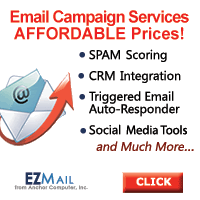Farmingdale, NY (PRWEB) June 28, 2009 -- New movers are highly motivated buyers and spend more on home-related purchases within the first three months of living in their new household versus current homeowners. Marketers can now reach these new prospects at the right time using Anchor's New Mover/New Connects data at affordable prices!
Anchor's customers will now have the option to inspect any New Mover/New Connects data they identify on their file before they buy. After evaluating the data Clients can choose to buy on a "Net Hit Basis" versus having to buy all the data available on a "Gross Basis".
What does this mean for marketers? Most list brokers ask for specific data details, run a query from their database and return all the data on their file. This is referred to as buying data on a "Gross Basis". Anchor, on the other hand, will provide our clients with daily or weekly New Movers/New Connects and allow the client to run it's own proprietary sort and report back only what is unique to their database. This we refer to as our "Net Hit Agreement Program".
"By using our 'New Mover/New Connects Net Hit Agreement Program', marketers will be able to reach new buyers when they are ready to purchase, stated Dean Kuzminski, Vice President, Phone Data Services". He continued, "I strongly urge marketers to contact us to compare our prices and results versus their current source".
Anchors "New Mover/New Connects Net Hit Agreement Program" enables marketers to:
|
Our New Mover/New Connects records are compiled from Telco and Multi-Sourced data feeds, which are updated, scrubbed, CASS™ verified and ZIP + 4® coded every 24 hours to ensure 100% accuracy and deliverability.
Anchor provides a complete array of Data Processing, Database Marketing and Document Personalization Services and Software to the direct marketing industry. For more information on all of our services, please visit www.AnchorComputer.com, call 1-800-452-2357







